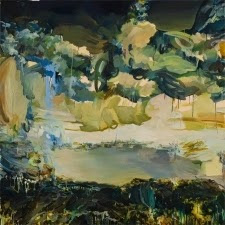THE ENTROPIC GESTURE: THE PAINTINGS OF ELSIE KAGAN
Elsie Kagan's painting is a form of revelation. It commingles a search for beauty with a sustained effort to manifest how reason, reality, and temperament can aid us in the creation of something new. Mining the history of artistic expression, searching for touchstones and wellsprings of inspiration, and being able to turn that research into a living and breathing new expression that can aptly invigorate the contemporary perception of beauty, is what Kagan does in her work.
Kagan's is not only a technical virtuosity but an educated
way of painting that refuses to lean on ability alone. It desires a greater
statement, one that is filled with the promise of creation and the threat of
destruction. There is a primal element in abundance that builds and drives her
interest in genres and art movements: a systematic use of energy that creates a
dynamic force within each work and throughout her entire oeuvre.
Kagan's system is her combined use of historical styles
commingling with a composed and manipulated brushwork and background tonality
to simultaneously achieve a look that is inspired by the classical past and yet
driven by a progressive need for gesture and idiosyncrasy. The themes and
motifs that inform and energize her work are bound up in the conflict between
the physical and the metaphysical, and in reading the details so specifically
that the overall structure merges with its colors, forms, and overall dynamism.
Over the last several years, Kagan has been working through
different genres of painting that span the entire history of classical and
modern expression, from a Renaissance muralism associated with the
architectural paintings of Michelangelo and Tintoretto, to the quasi-religious
arrangements of sexual poses by Peter Paul Rubens, to the mythical or
spiritually infused landscapes of David, Friedrich, and Bocklin; to portrayals
of landscape as depictions of manifest destiny in works by Alfred Bierstadt and
Thomas Cole; up to a confrontation with mid century expressionism.
Each of the different periods in Kagan's growth as an artist
reflects not only her struggle between subject matter and style, but also a
willingness to allow chaotic forces to undermine perception. This is what
differentiates her from any painter of bourgeois values. In her hands, the
traditional norms, and the tropes which emerge from them, are perceptually
radicalized. Her work makes new versions of old ideas but she also tramples
well enough upon them to not only replace the shopworn associations we have
with their sources, but to stylistically atomize the images.
Second, she explodes the forms themselves, using limited but
effusive colors, with bursts above and dense tangle of root-like forms below.
Chromatically, she does not hew to just red, green, yellow, etc, but pulls
strands of color out of enclosed sections to wander into the foreground like a
scent come alive. These play foil to the concept of an organized and realistic
event while still showing how much energy is at work.
Thirdly, Kagan erases whole areas of the central figure,
leaving only a silhouette, and creating a negative space that could possibly
represent a flower in the bouquet that has gone missing, or that never existed,
or only existed in dreams. Kagan leaves it up to the viewer to do the work of
imagining the rest.
In her landscapes, there is a likewise a tweaking of forms
and a stylistically rough or thorny handling of gesture to capitalize on
implied narrative, theme, and mood, and to impose the structural chaos that is
her leitmotif. Works such as the problem of space remained, nothing was simply
one thing (2013), ways to be good and happy, and way and by (2012), each create
a specific challenge that enlarges her ability to manifest an entropic quality
as a foil against historical bias and a way to move perception of a traditional
form into a contemporary context.
The organizational and gestural difficulties in each relate
to: a painting of space, assessed and dramatized yet not satisfactorily
addressed; the temptation to anthropomorphize simple aspects of an image that
are equally illustrated as depicted; reimagining a heroic mise-en-scene that
sets the stage for an event which never occurs--the appearance of a heavenly
host, when in fact, the heavens parting is enough to want in the first place.
The ironic displacement of a heroic presence is underscored by the parting of
clouds as if they were curtains on a stage; and what seem to be ships cruising
across a rough sea, little ships of early exploration; turn out to be sheets
billowing in a midday breeze or large leaves on alien trees. Dense with detail,
color, and gesture, each of these works establishes a new way for us to look at
painting as an activity in the present and a history in the past.




Comments